Abstract
Mycobacterium haemophilum was isolated from wrist and ankle aspirates as the organism responsible for tenosynovitis in a patient with acquired immune deficiency syndrome. Mycobacterium isolates recovered from synovial fluid were identified as hemin requiring by their failure to grow on subculture unless the medium was supplemented with hemin. M. haemophilum is of low virulence and rarely associated with infections in humans. This is the first documented case of M. haemophilum infection in a patient with acquired immune deficiency syndrome.
Full text
PDF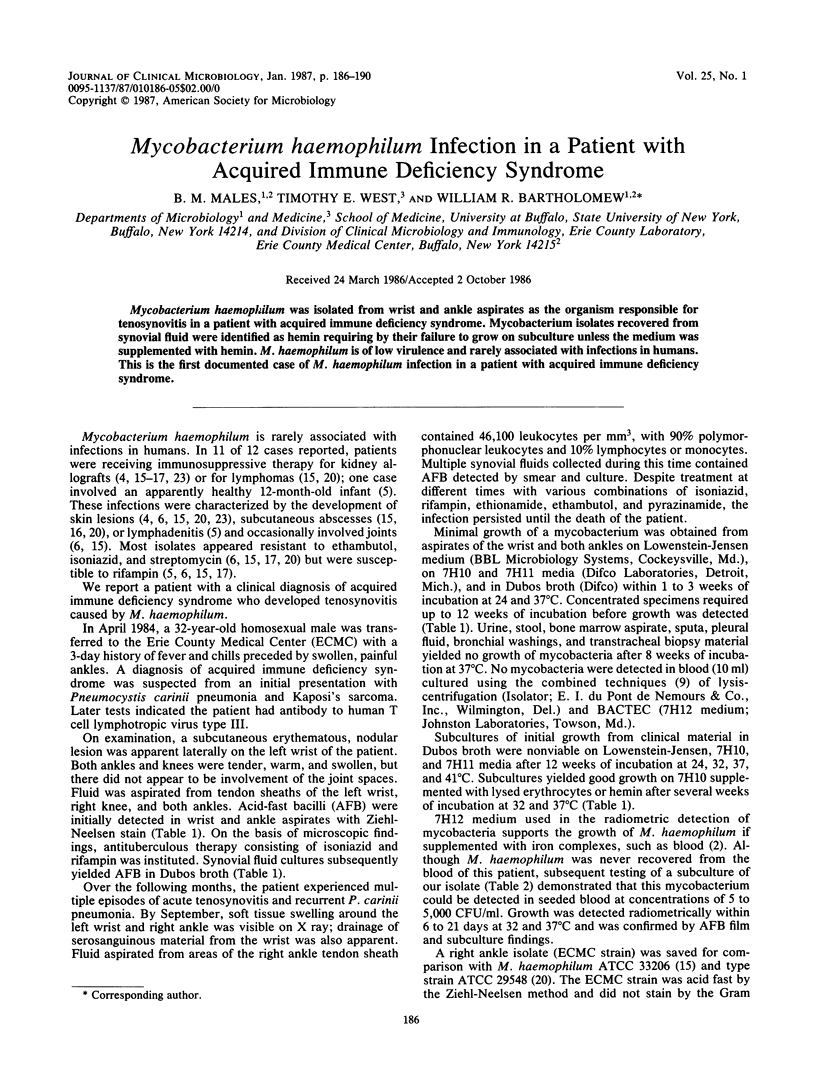
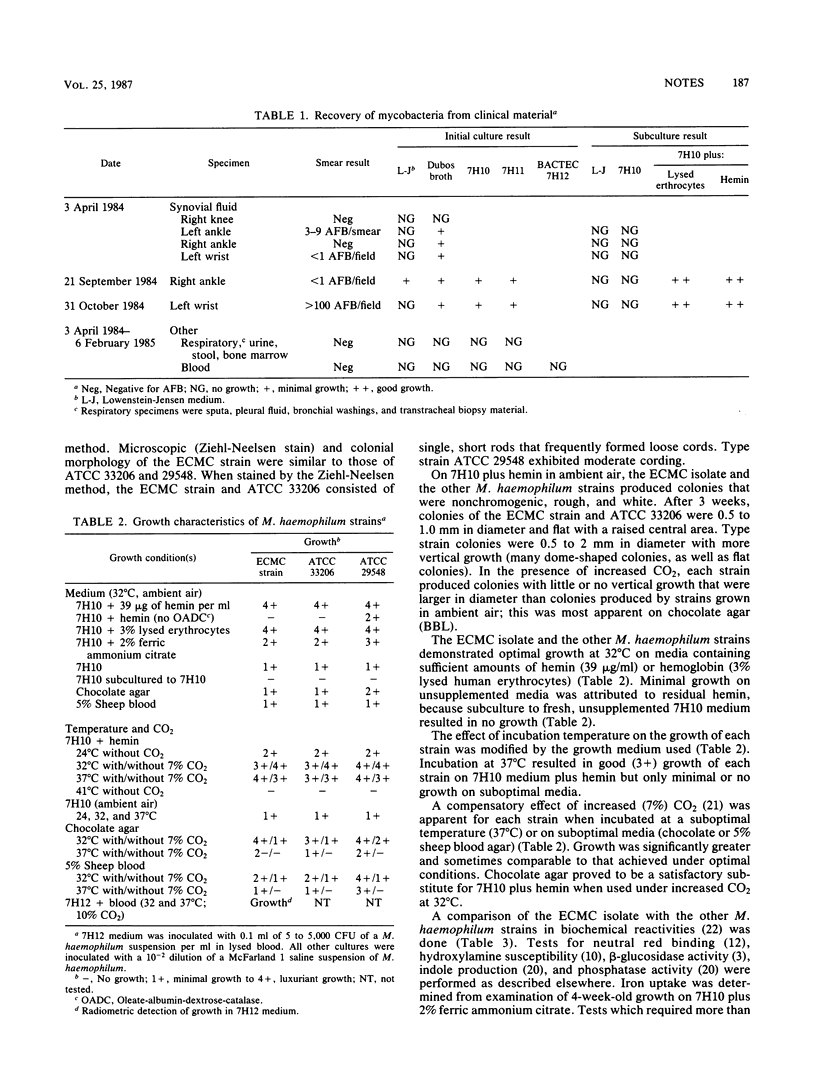
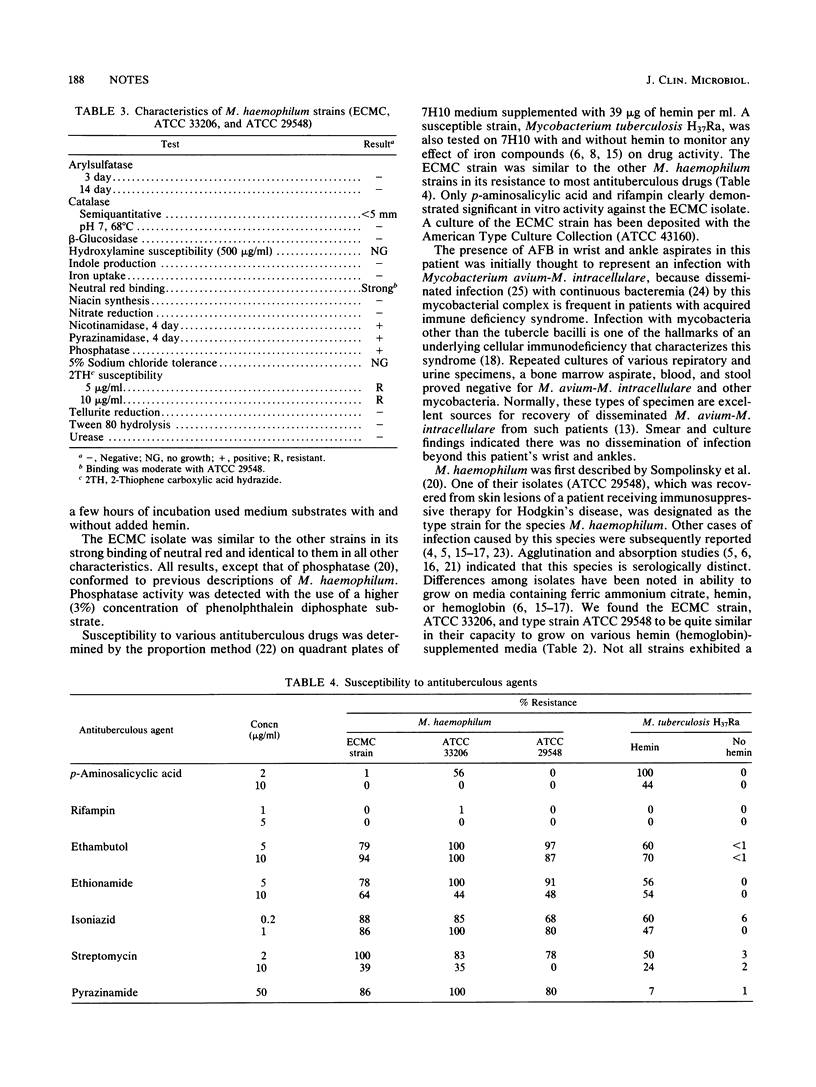
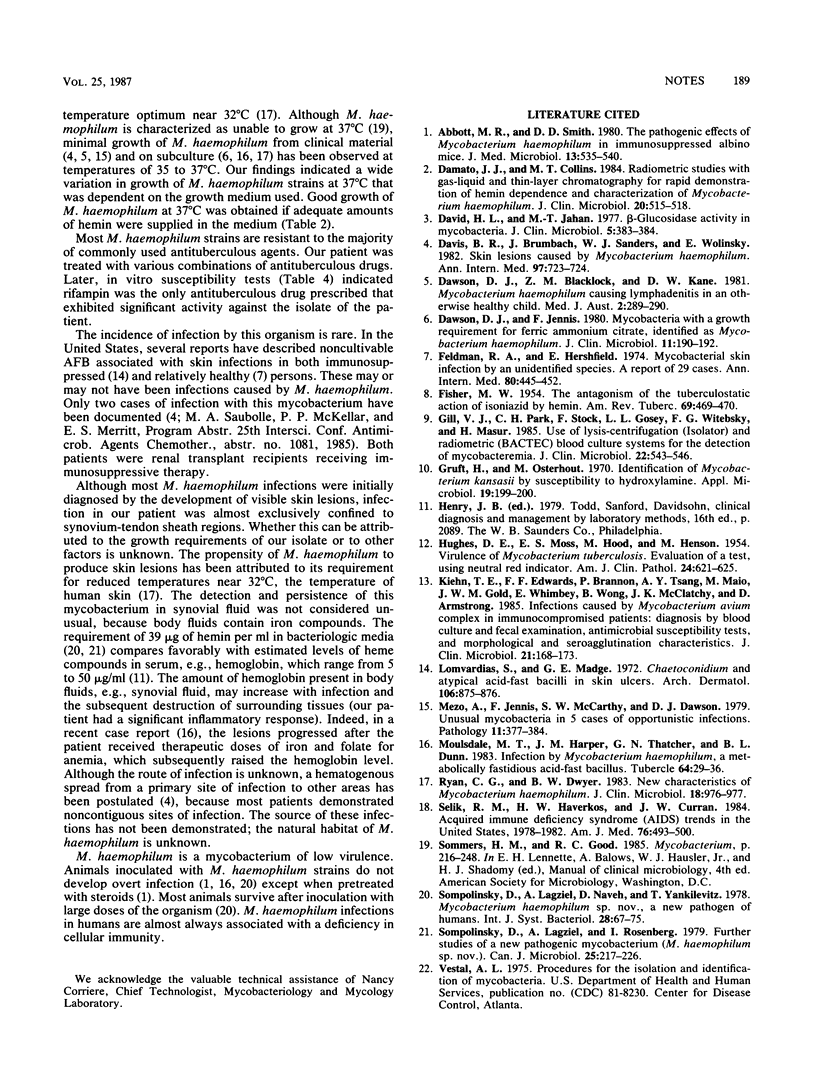
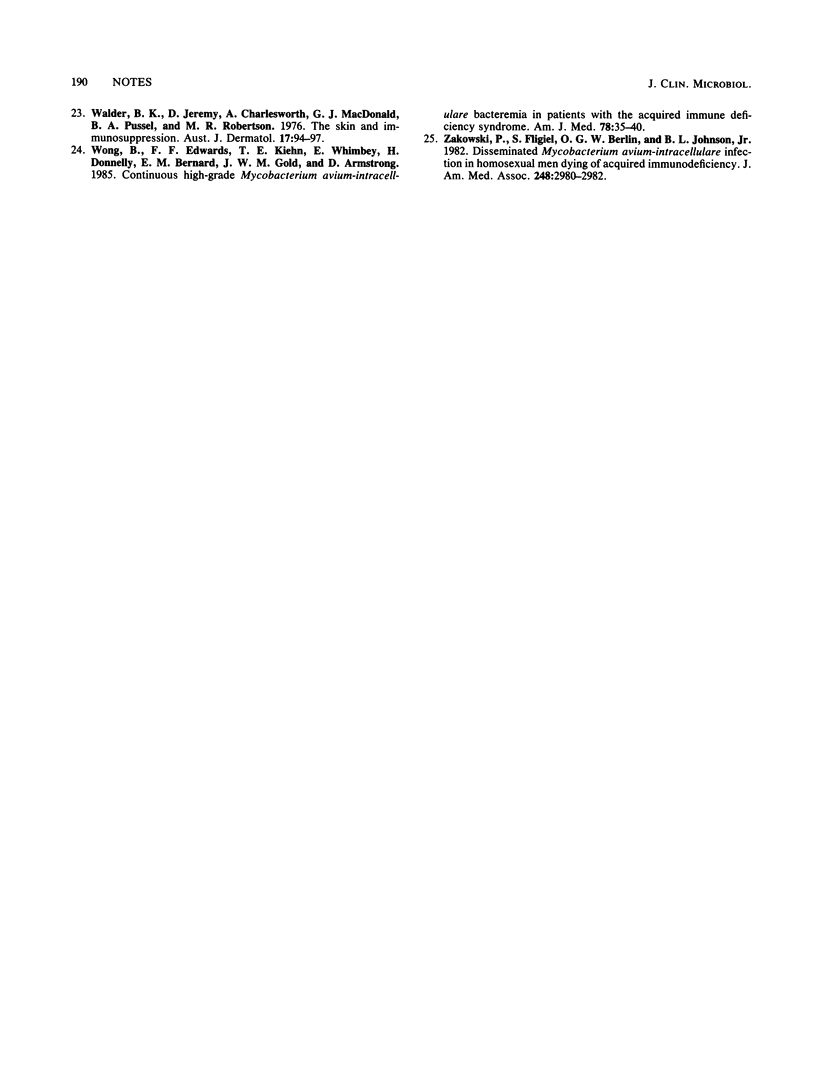
Selected References
These references are in PubMed. This may not be the complete list of references from this article.
- Abbott M. R., Smith D. D. The pathogenic effects of Mycobacterium haemophilum in immunosuppressed albino mice. J Med Microbiol. 1980 Nov;13(4):535–540. doi: 10.1099/00222615-13-4-535. [DOI] [PubMed] [Google Scholar]
- Damato J. J., Collins M. T. Radiometric studies with gas-liquid and thin-layer chromatography for rapid demonstration of hemin dependence and characterization of Mycobacterium haemophilum. J Clin Microbiol. 1984 Sep;20(3):515–518. doi: 10.1128/jcm.20.3.515-518.1984. [DOI] [PMC free article] [PubMed] [Google Scholar]
- David H. L., Jahan M. T. beta-Glucosidase activity in mycobacteria. J Clin Microbiol. 1977 Mar;5(3):383–384. doi: 10.1128/jcm.5.3.383-384.1977. [DOI] [PMC free article] [PubMed] [Google Scholar]
- Davis B. R., Brumbach J., Sanders W. J., Wolinsky E. Skin lesions caused by Mycobacterium haemophilum. Ann Intern Med. 1982 Nov;97(5):723–724. doi: 10.7326/0003-4819-97-5-723. [DOI] [PubMed] [Google Scholar]
- Dawson D. J., Blacklock Z. M., Kane D. W. Mycobacterium haemophilum causing lymphadenitis in an otherwise healthy child. Med J Aust. 1981 Sep 19;2(6):289–290. doi: 10.5694/j.1326-5377.1981.tb128321.x. [DOI] [PubMed] [Google Scholar]
- Dawson D. J., Jennis F. Mycobacteria with a growth requirement for ferric ammonium citrate, identified as Mycobacterium haemophilum. J Clin Microbiol. 1980 Feb;11(2):190–192. doi: 10.1128/jcm.11.2.190-192.1980. [DOI] [PMC free article] [PubMed] [Google Scholar]
- FISHER M. W. The antagonism of the tuberculostatic action of isoniazid by Hemin. Am Rev Tuberc. 1954 Mar;69(3):469–470. doi: 10.1164/art.1954.69.3.469. [DOI] [PubMed] [Google Scholar]
- Feldman R. A., Hershfield E. Mycobacterial skin infection by an unidentified species. A report of 29 patients. Ann Intern Med. 1974 Apr;80(4):445–452. doi: 10.7326/0003-4819-80-4-445. [DOI] [PubMed] [Google Scholar]
- Gill V. J., Park C. H., Stock F., Gosey L. L., Witebsky F. G., Masur H. Use of lysis-centrifugation (isolator) and radiometric (BACTEC) blood culture systems for the detection of mycobacteremia. J Clin Microbiol. 1985 Oct;22(4):543–546. doi: 10.1128/jcm.22.4.543-546.1985. [DOI] [PMC free article] [PubMed] [Google Scholar]
- Gruft H., Osterhout M. Identification of Mycobacterium kansasii by susceptibility to hydroxylamine. Appl Microbiol. 1970 Jan;19(1):199–200. doi: 10.1128/am.19.1.199-200.1970. [DOI] [PMC free article] [PubMed] [Google Scholar]
- HUGHES D. E., MOSS E. S., HOOD M., HENSON M. Virulence of Mycobacterium tuberculosis: evaluation of a test, using neutral red indicator. Am J Clin Pathol. 1954 May;24(5):621–625. doi: 10.1093/ajcp/24.5_ts.621. [DOI] [PubMed] [Google Scholar]
- Kiehn T. E., Edwards F. F., Brannon P., Tsang A. Y., Maio M., Gold J. W., Whimbey E., Wong B., McClatchy J. K., Armstrong D. Infections caused by Mycobacterium avium complex in immunocompromised patients: diagnosis by blood culture and fecal examination, antimicrobial susceptibility tests, and morphological and seroagglutination characteristics. J Clin Microbiol. 1985 Feb;21(2):168–173. doi: 10.1128/jcm.21.2.168-173.1985. [DOI] [PMC free article] [PubMed] [Google Scholar]
- Lomwardias S., Madge G. E. Chaetoconidium and atypical acid-fast bacilli in skin ulcers. Arch Dermatol. 1972 Dec;106(6):875–876. doi: 10.1001/archderm.106.6.875. [DOI] [PubMed] [Google Scholar]
- Mezo A., Jennis F., McCarthy S. W., Dawson D. J. Unusual mycobacteria in 5 cases of opportunistic infections. Pathology. 1979 Jul;11(3):377–384. doi: 10.3109/00313027909059014. [DOI] [PubMed] [Google Scholar]
- Moulsdale M. T., Harper J. M., Thatcher G. N., Dunn B. L. Infection by Mycobacterium haemophilum, a metabolically fastidious acid-fast bacillus. Tubercle. 1983 Mar;64(1):29–36. doi: 10.1016/0041-3879(83)90047-8. [DOI] [PubMed] [Google Scholar]
- Ryan C. G., Dwyer B. W. New characteristics of Mycobacterium haemophilum. J Clin Microbiol. 1983 Oct;18(4):976–977. doi: 10.1128/jcm.18.4.976-977.1983. [DOI] [PMC free article] [PubMed] [Google Scholar]
- Selik R. M., Haverkos H. W., Curran J. W. Acquired immune deficiency syndrome (AIDS) trends in the United States, 1978-1982. Am J Med. 1984 Mar;76(3):493–500. doi: 10.1016/0002-9343(84)90669-7. [DOI] [PubMed] [Google Scholar]
- Sompolinsky D., Lagziel A., Rosenberg I. Further studies of a new pathogenic mycobacterium (M. haemophilum sp. nov.). Can J Microbiol. 1979 Feb;25(2):217–226. doi: 10.1139/m79-033. [DOI] [PubMed] [Google Scholar]
- Walder B. K., Jeremy D., Charlesworth J. A., Macdonald G. J., Pussell B. A., Robertson M. R. The skin and immunosuppression. Australas J Dermatol. 1976 Dec;17(3):94–97. doi: 10.1111/j.1440-0960.1976.tb00798.x. [DOI] [PubMed] [Google Scholar]
- Wong B., Edwards F. F., Kiehn T. E., Whimbey E., Donnelly H., Bernard E. M., Gold J. W., Armstrong D. Continuous high-grade mycobacterium avium-intracellulare bacteremia in patients with the acquired immune deficiency syndrome. Am J Med. 1985 Jan;78(1):35–40. doi: 10.1016/0002-9343(85)90458-9. [DOI] [PubMed] [Google Scholar]
- Zakowski P., Fligiel S., Berlin G. W., Johnson L., Jr Disseminated Mycobacterium avium-intracellulare infection in homosexual men dying of acquired immunodeficiency. JAMA. 1982 Dec 10;248(22):2980–2982. doi: 10.1001/jama.1982.03330220024029. [DOI] [PubMed] [Google Scholar]


